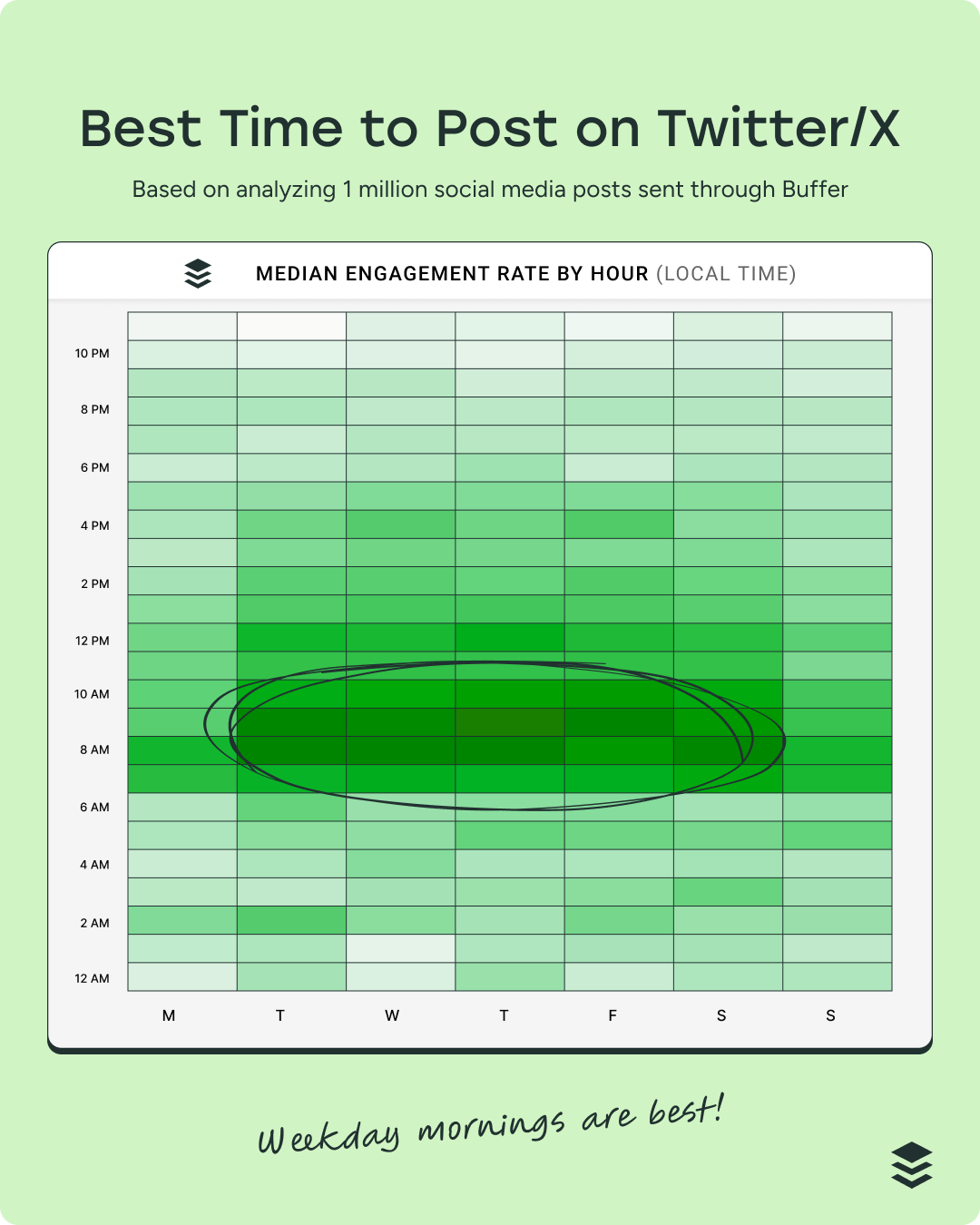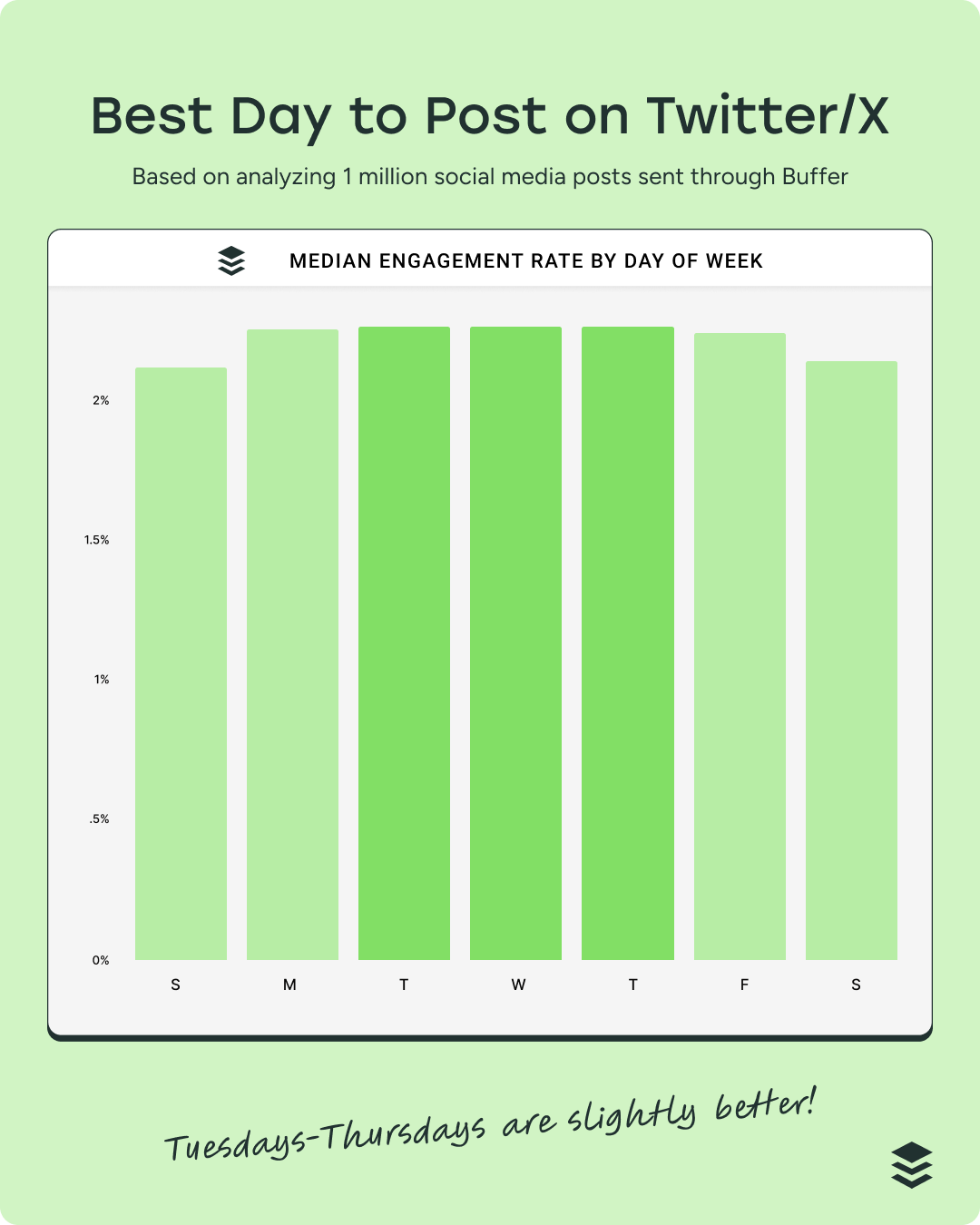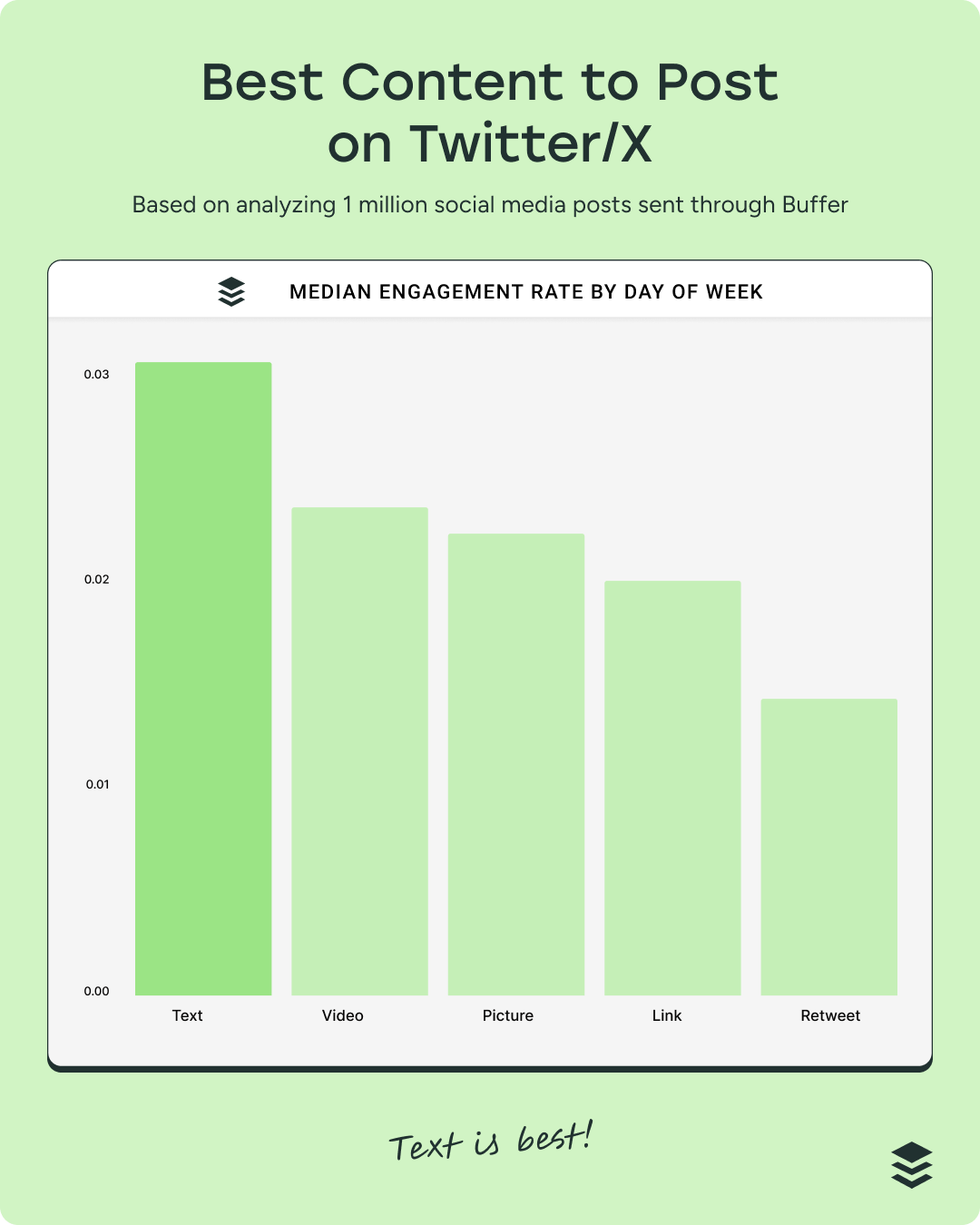Timing can make or break many things: Heating leftover pizza in the microwave, delivering a punchline for a joke, canceling a free trial — and it’s no less important when it comes to the best time to post on Twitter.
OK, OK: Posting your tweets at the right time might not be as critical as, say, preventing soggy pizza, but it’s still an important consideration when it comes to your social media marketing strategy.
I hear what you’re thinking: X no longer has a chronological feed — how can the time you post matter so much when X’s algorithm is in the driver’s seat?
Posting times might not be as vital as they were in Twitter’s early days, but they still seem to affect content performance on X.
Remember: X/Twitter’s algorithm values engagement — which is why we used engagement rate as the metric to measure the success of more than 1 million tweets sent through Buffer.
Our findings were fascinating. We uncovered definite patterns in what posting times, days, and content types tend to get more engagement than others, helping us make some recommendations about not only the best time to post on Twitter, but the best day and the best content format to post as well.
Let’s take a closer look.
Jump to a section:
- The best time to post on Twitter/X
- The best time to post on Twitter/X on Monday
- The best time to post on Twitter/X on Tuesday
- The best time to post on Twitter/X on Wednesday
- The best time to post on Twitter/X on Thursday
- The best time to post on Twitter/X on Friday
- The best time to post on Twitter/X on Saturday
- The best time to post on Twitter/X on Sunday
- The best time to post on Twitter/X for each day of the week
- The best and worst days of the week to post on Twitter/X
- The best type of content to post on Twitter/X
- The best time for you to post on Twitter/X
- Your checklist for high-performing X/Twitter posts
The best time to post on Twitter/X
| Rank | Best Time to Post | Day |
|---|---|---|
| 🥇 1st | 9 a.m. | Wednesday |
| 🥈 2nd | 8 a.m. | Tuesday |
| 🥉 3rd | 8 a.m. | Monday |
The best time to post on Twitter or X is 9 a.m. on Wednesday. Tweets posted at those times tend to have the highest engagement rates, according to our analysis of more than 1 million tweets.
The next best time to post on Twitter is Tuesday at 8 a.m., followed by Monday at 8 a.m.
🌅 Tweeting during mid-morning every weekday tends to yield solid engagement. Other notable posting times are all during this morning period.

The darkest slots represent the time slots with the highest engagement rates and, we extrapolate, the best time to post on Facebook. The light to white blocks are the time slots with the lowest engagement — times that are perhaps left out of your posting schedule.
According to demographic data from Statista, 37.5% of Twitter users are between 25 and 34. The second-largest age group of users, 32.1%, are between 18 and 24. This suggests that Twitter users are likely logging on to check their feeds as they arrive and settle in at work in the morning.
On most weekdays, the peak hours for social media engagement are similar. Engagement tends to climb from the early morning on weekdays, peaking at around 9 a.m., then slowly petering out in the early afternoon, towards the end of the workday.
The best time to post on Twitter/X by day of the week
| Day | Best Time #1 | Best Time #2 | Best Time #3 |
|---|---|---|---|
| Monday | 8 a.m. | 9 a.m. | 10 a.m. |
| Tuesday | 8 a.m. | 9 a.m. | 10 a.m. |
| Wednesday | 9 a.m. | 8 a.m. | 10 a.m. |
| Thursday | 9 a.m. | 8 a.m. | 10 a.m. |
| Friday | 8 a.m. | 9 a.m. | 7 a.m. |
| Saturday | 8 a.m. | 7 a.m. | 9 a.m. |
| Sunday | 8 a.m. | 7 a.m. | 9 a.m. |
The best time to post on Twitter/X on Monday
The best time to post on Twitter on Monday for maximum engagement is 8:00 a.m., with other optimal posting times at 9 a.m. and 10 a.m. Early morning tweets tend to perform well as our data suggests Twitter users tend to check their feeds before diving into work.
The best time to post on Twitter/X on Tuesday
The best time to post on Twitter or X on Tuesday is 8 a.m., followed closely by 9 a.m. and 10 a.m. This makes sense — Tuesday is one of the highest engagement days on the platform, with users settling into their weekly routines.
The best time to post on Twitter/X on Wednesday
The best time to post on Twitter on Wednesday is 9 a.m., with 8 a.m. and 10 a.m. also being strong posting windows. Midweek engagement peaks as people look for fresh content while taking a break from work. Wednesday is definitely worth adding to your posting schedule, too, as these slots were among the peak times in our analysis. High engagement time slots tend to go slightly later on Wednesday too, with some early afternoon times offering good results.
The best time to post on Twitter/X on Thursday
On Thursday, the best time to post on Twitter is 9 a.m., with 8 a.m. and 10 a.m. also performing well. As the weekend approaches, engagement remains high as users look for updates and trending conversations.
The best time to post on Twitter/X on Friday
The best time to post on Friday is 8 a.m., with 9 a.m. and 7 a.m. also being optimal posting times for maximum engagement. Morning tweets tend to do best as people check Twitter before winding down for the weekend.
The best time to post on Twitter/X on Saturday
Saturday engagement is lower overall, but the best time to post on Twitter is 8 a.m., with other peak hours at 7 a.m. and 9 a.m. Even on the weekend, early-morning posting times tend to perform better than later in the day.
The best time to post on Twitter/X on Sunday
Sunday has the lowest engagement levels, but if you must tweet on Sunday, the best time to post on Twitter is 8 a.m., with 7 a.m. and 9 a.m. also being peak times to post for maximum engagement on this slower day.
The best and worst days of the week to post on Twitter/X
The best day of the week to tweet is Tuesday. Wednesday comes in second place in terms of engagement on the platform, and Thursday comes third (though, as you’ll see from the graph below, Monday and Friday aren’t too far behind).

The worst day of the week to post on Twitter is Sunday, with Saturday only slightly better. While some posting times seem to see solid engagement on the weekend, you’re probably better off sticking to tweeting on weekdays.
If you prefer to batch-prep content for your Twitter account during downtime on the weekends (high five for that), you might want to schedule posts for weekdays instead.
This is where social media scheduling tools like Buffer really shine. Experiment by systematically going through the times on the list above, scheduling posts in those slots, and then tracking their social media performance to see what works best for your specific target audience.
The best type of content to post on Twitter/X
Despite X’s ongoing push for video — rolling out longer uploads, higher resolution options, and even revenue-sharing for video creators — our data shows that text-based posts still reign supreme when it comes to engagement.

Text posts received 30.04% more engagement than video posts and 37.10% more engagement than image or photo posts.
It makes sense when you think about what sets X apart from other social platforms. While TikTok, Instagram, and YouTube are battling for video dominance, X has always been a text-first platform — a place for real-time updates, hot takes, and punchy one-liners.
That said, video did outperform image posts, earning 5.43% more engagement than pictures.
On the other end of the spectrum, posts with links and retweets were both poorer performers. The former makes sense — social media platforms tend to want to keep users there, rather than having them click out to other content and sites.
The performance of retweets (which includes quote tweets, too) is also worth noting. While it’s a great way to show support for other creators, retweets shouldn’t be a primary focus if you’re looking to grow your following on X.
The best time for you to post on Twitter/X
While tweeting at specific times may yield brilliant results right out the gate, it’s not a given that some timing tweaks will supercharge your content’s performance on X.
How come? Well, all target audiences are different. The timing that works to engage one cohort may not work for another. While the general best times to post on Twitter are a great jumping-off point, it’s important to fine-tune your social media strategy and figure out what gets the best results for you.
Now, how do you do that? Especially now that, unlike other social media platforms, Twitter analytics are behind the paywall of X Premium.
A social media management tool like Buffer can help. Buffer’s X analytics compares the performance of all your tweets and connects the dots for you. Here, you’ll find recommendations for:
- The best day of the week for you to post
- The best content format to post (image, video, text, or link)
- How often to post per day or week
To find them:
- Make sure your X profile is connected as a channel in Buffer.
- Head to the Analytics tab at the top left.
- Here, you’ll find your Analytics Overview. You’ll see how your content has performed over the period you set with the date dropdown on the top right.
- Click on the Answers tab. You’ll find all of the recommendations I mentioned above in this window.
- Click on the Posts tab to see the performance of specific tweets and hashtags.
🎉 Try out Buffer's Analytics for free for 14 days, so you can put all the features I've mentioned in this article (plus loads of other social media platforms and features) to the test. We offer basic analytics on our free plan too! Get started here →
Your checklist for high-performing X/Twitter posts
Nailing down the best time to post can give your content a better chance of success — but even the perfect time is not a magic spell for going viral on Twitter.
There are a host of factors at play here when it comes to success on the platform. If you want to grow your following on X and social media presence as a whole, tick all the boxes below.
- Conduct a profile audit: A half-finished or unappealing profile won’t earn you any new followers. Make sure your Twitter account profile is complete, with a high-quality profile picture and cover image, a thorough bio, and a link-in-bio URL.
- Comment on global events: X is where folks turn for up-to-the-minute, real-time news and commentary. If something is gaining traction in your niche, share your opinion.
- Post visual content: As discussed above, video tends to perform best, but it’s worth experimenting with photos and other images to see what resonates with your followers.
- Connect with your followers: Don’t post and ghost — remember that Twitter is a social platform. Engage with your followers by responding to their comments and DMs and connecting with other Twitter influencers/creators in your niche.
- Lean into strong hooks: Gain followers by getting your audience emotionally invested from the very first line. Use a strong statement, a straightforward question, an eye-popping statistic, or a teaser that hints at an unfolding story.
- Share real-life stories: Connect with your audience on a human level by sharing relatable content about your life.
- Be consistent: X is a particularly fast-paced platform — post daily (or multiple times if you have the bandwidth) if you’re committed to growing your Twitter account.
- Keep an eye on your analytics: Use the methods above to learn from your metrics and take action.
- Consider X Premium: Buffer’s Tami Oladipo put X Premium to the test and uncovered what seemed to be an uptick in post performance.
For more details on the above, be sure to check out our guide to getting more followers on Twitter.
What have you found most helpful when determining your best time to post on X/Twitter? Let us know @buffer on all our social media accounts!
Try Buffer for free
190,000+ creators, small businesses, and marketers use Buffer to grow their audiences every month.




